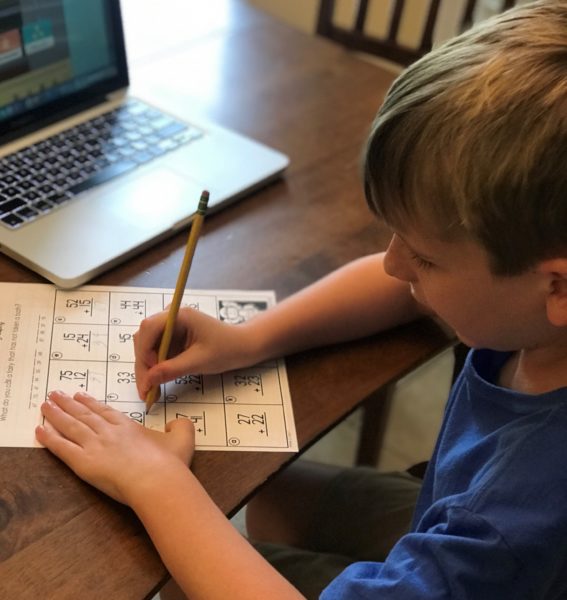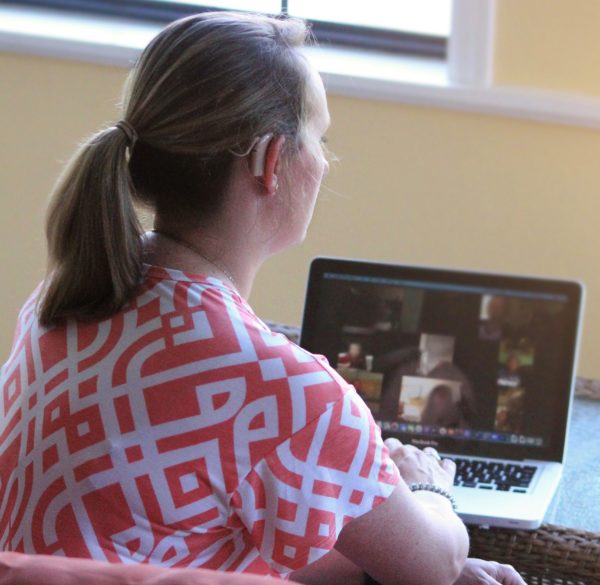For second grade teacher, Holly P. and her students, Friday, March 13 was the last “normal” day of the school year, although they didn’t know it at the time. It started like a regular day but chatter quickly arose about the impending Covid-19 Pandemic. As a teacher, parent and cochlear implant recipient there was little time to adjust to distance learning, but technology helped pave the way. Read about Holly’s experience.
“It started as a normal school day but by lunchtime on Friday, March 13, we learned that our class field trip for the following Monday was cancelled. My second-grade class was understandably disappointed. I assured them that we would have a fun day on Monday and hopefully our field trip could be rescheduled. That afternoon, I gave my students a hug or high five on the way out the door and told them I would see them Monday. I was wrong. That same afternoon, Governor Kay Ivey issued an order that would close all Alabama schools at the end of the day on March 18, effective until April 6. Later that weekend, our superintendent decided to close schools in the county immediately. An “extended Spring Break” turned into schools being closed for the remainder of the year. This tailspin of events was the beginning of a radical change in education as we all knew it; teachers, students, and parents were about to learn a new normal as we faced the task of distance learning.
A quick shift in learning
My school is in a district where many students do not have Internet access. Therefore, parents were given a choice of a paper learning packet or online learning. Teachers were allowed back into our empty classrooms for one day to prepare packets and upload assignments to Google Classroom.
Most of the assignments were a review of previously learned material; however, some assignments covered new content. I wanted to provide instruction to my students to help them through this, although I knew the limited technology for some would be a challenge. I found a screencast program, Screencastify, that allowed me to record myself teaching, while sharing my screen to work through the questions just like we would in class. I was excited to discover that I could send these videos to all my students’ parents through text; even students without Internet access were able to view them.
Maintaining contact and interaction
One major challenge for educators during distance learning is simply being away from our students. Nothing can take the place of in-person, classroom instruction and social interaction. I decided to host weekly Zoom meetings for my class. These meetings gave us a chance to talk and see each other. We did fun activities like pet show and tell, scavenger hunts, pajama party bedtime stories, and made ice cream in a bag. Although all my students were not able to attend Zoom meetings, I still maintained contact with parents and students through phone calls or texts. During these weekly conversations, I was able to check on my students academically and emotionally to provide help as needed.
A teacher, a parent, a recipient
Another challenge that I faced was handling my own child’s schoolwork while providing for my students during distance learning. I had to carefully manage our time at home so that we could both accomplish what we needed to each day. We found a certain time of day that worked best, for him it was mid-morning. I made sure he had his work completed in a timely manner so that I was able to focus on what I needed to do for my students in the afternoon. Often, while I was making phone calls to parents, he used the computer to work on online educational programs.
Throughout the last few months, a thought has frequently crossed my mind. If distance learning had happened a year earlier, I would not have been able to do this. In June 2019, I received a Cochlear™ Nucleus 7® Sound Processor.* Prior to this, I was on the verge of quitting the job I love, because my hearing loss had become more than I could handle. This was my first year of teaching with my cochlear implant, and it completely changed everything for the better. I never thought I would say my cochlear implant would help me survive teaching in a pandemic, but it did!
Distance teaching with my cochlear implant
Distance learning would have been extremely difficult for me without my cochlear implant. Simple things like making phone calls and FaceTime were made so much easier, because of my cochlear implant’s direct streaming to iPhone® capabilities.** When creating teaching videos, I spent a lot of time recording, watching the videos, and then re-recording if needed. Without being able to hear clearly this would have been extremely difficult. Zoom meetings, with both my students, and staff, would have probably been impossible for me, as I could not have understood speech through the computer speaker. Thanks to my cochlear implant I was able to do all these things successfully, and that is just one reason I am grateful for this amazing technology!
Lessons learned
As this school year is ending, there are already questions about what school will be like next year. If we can return to a regular, in-person school year, I would take back several things that I have learned during our time away. Teaching videos texted to parents would be an easy way to provide instruction to students who are absent. Zoom calls or FaceTime could be used if a student needs extra help after school. I believe we have had so much amazing technology at our fingertips without realizing it, and distance learning has allowed us to see it. If we are still doing distance learning in the fall, I would encourage parents to reach out to their child’s teachers. They really do want to help. In fact, if you’re an educator or a parent of a school-aged child with cochlear implants or significant hearing loss, Cochlear’s School Resource Center has tools and materials to assist in learning.
As a parent, I have realized that learning at home is so much different than learning at school. Don’t expect perfection; take it day by day and do what is best for you and your child. Take lots of breaks. Snuggle up and read a book. Do whatever it takes to keep your child happy, while learning at the same time. Whatever school looks like next year, I know we can make it work together.”
Learn how Cochlear hearing solutions work and discover how they could help you or your loved one.
* The Cochlear Nucleus 7 Sound Processor is compatible with iPhone, iPad and iPod touch. Apple, the Apple logo, FaceTime, iPhone, are trademarks of Apple Inc., registered in the U.S. and other countries.
Android is a trademark of Google LLC. Google Play and the Google Play logo are trademarks of Google LLC.
** Direct streaming available only with the Nucleus 7 Sound Processor from a compatible Apple® or Android™ device. For compatibility information, visit www.cochlear.com/compatibility.


